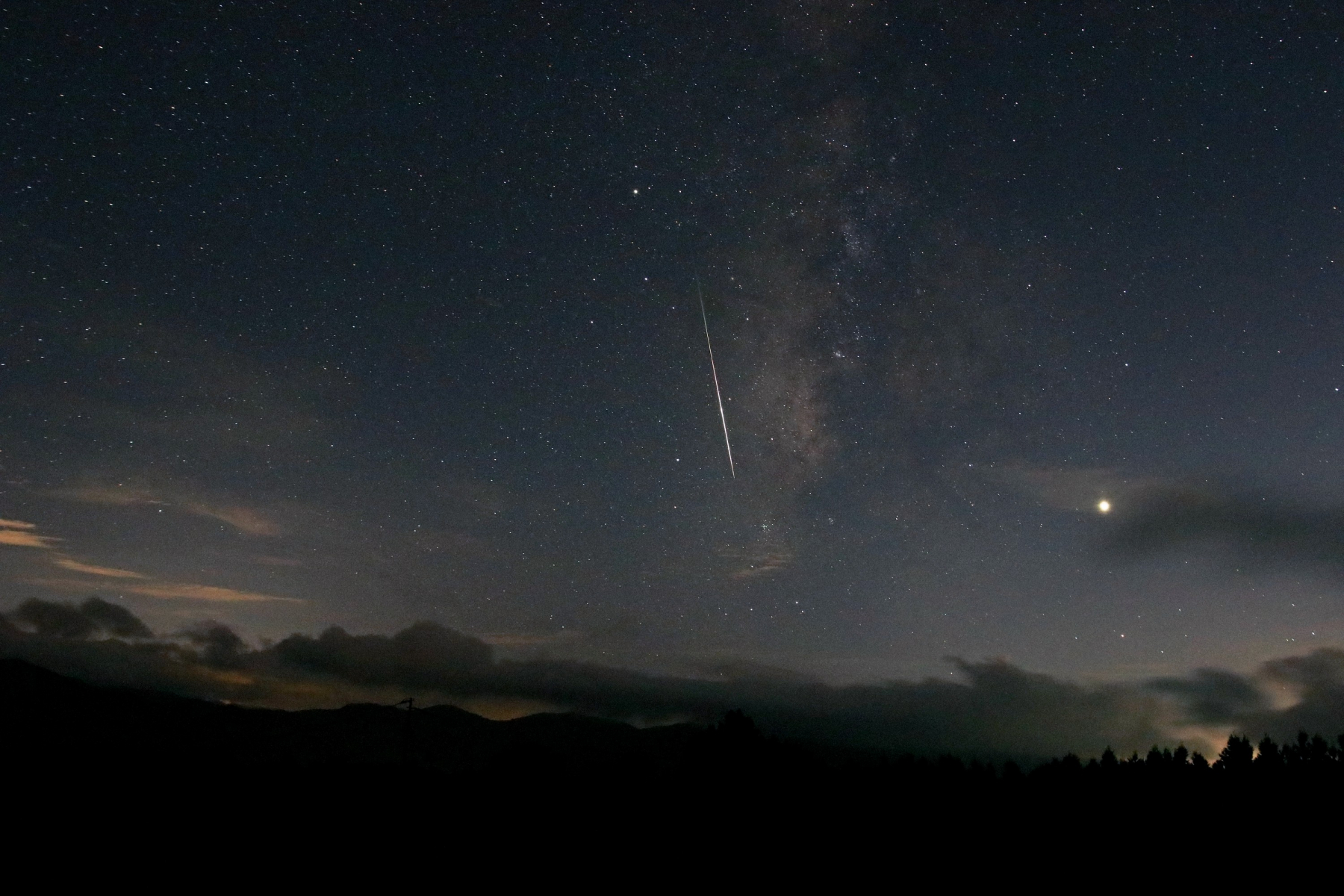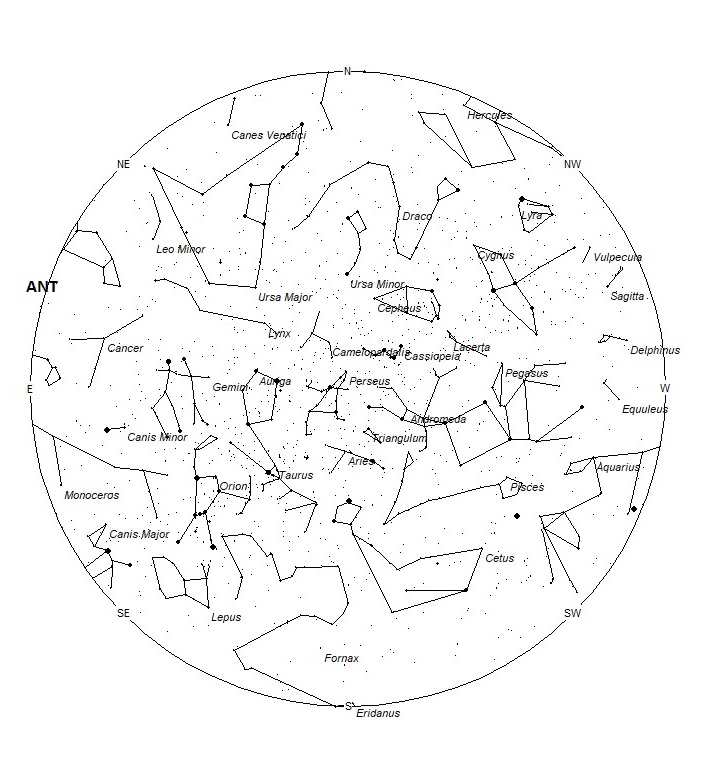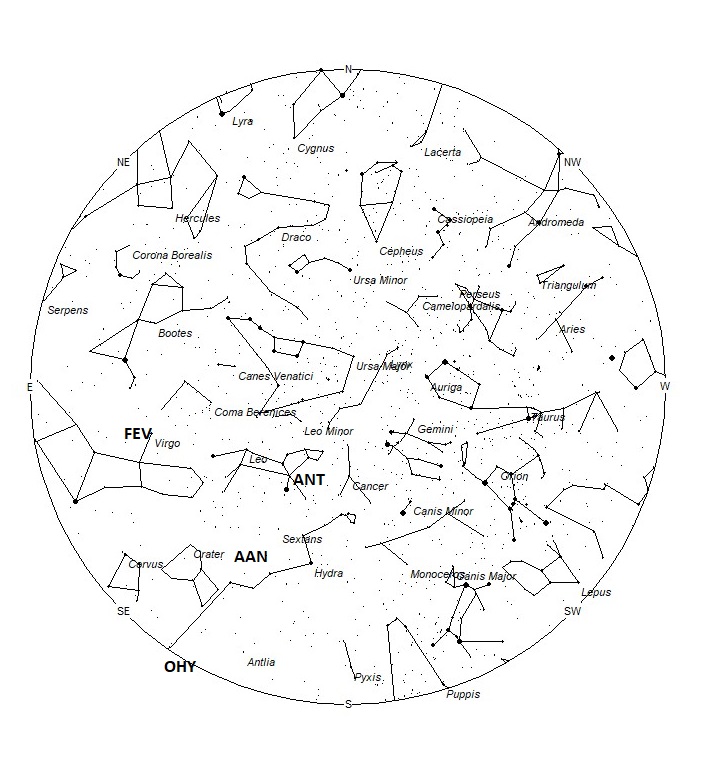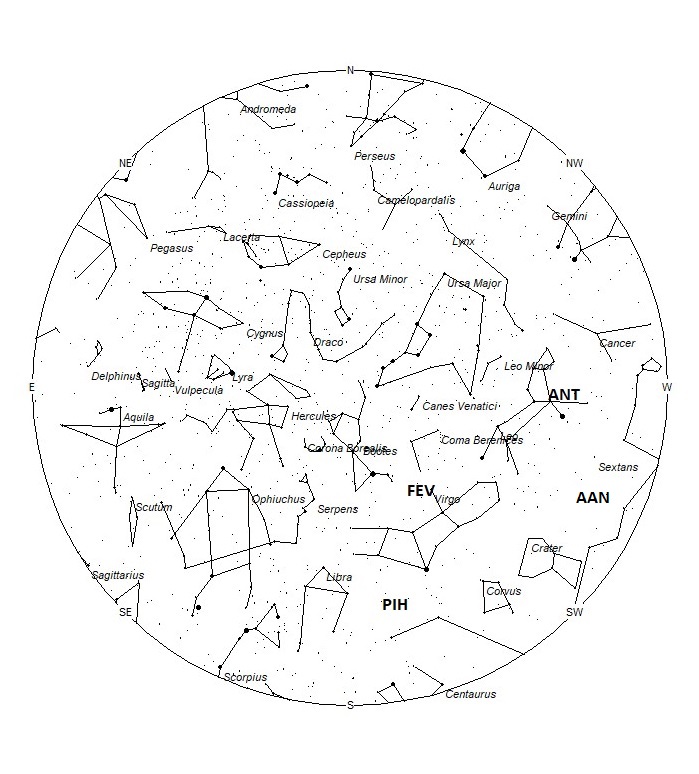
February offers the meteor observer in the northern hemisphere a couple of weak showers plus falling sporadic rates. This may not seem too exiting but you never know when surprises are in store. An errant earthgrazer from the Centaurid complex may shoot northward. Better yet, a bright fireball may light up the sky. February is the start of the evening fireball season, when an abundance of fireballs seem to occur. This lasts well into April as seen from the northern hemisphere. Sporadic rates are near maximum for those viewing from the Southern hemisphere. There are no strong showers this month, but sporadic rates are in excess of 10 per hour as seen from mid-southern latitudes.
During this period the moon reaches its first quarter phase on Sunday February 2nd. At this time the moon will lie 90 degrees east of the sun and will set between midnight and 01:00 local standard time (LST). As the week progresses the waxing gibbous moon will enter the morning sky, shrinking the window of opportunity to view meteor activity under dark skies. The estimated total hourly meteor rates for evening observers this week is near 2 for those viewing from the northern hemisphere and 3 for those located south of the equator. For morning observers the estimated total hourly rates should be near 11 as seen from mid-northern latitudes (45N) and 14 as seen from tropical southern locations (25S). The actual rates will also depend on factors such as personal light and motion perception, local weather conditions, alertness and experience in watching meteor activity. Evening rates are reduced during this period due to moonlight. Note that the hourly rates listed below are estimates as viewed from dark sky sites away from urban light sources. Observers viewing from urban areas will see less activity as only the brighter meteors will be visible from such locations.
The radiant (the area of the sky where meteors appear to shoot from) positions and rates listed below are exact for Saturday night/Sunday morning February 1/2. These positions do not change greatly day to day so the listed coordinates may be used during this entire period. Most star atlases (available at science stores and planetariums) will provide maps with grid lines of the celestial coordinates so that you may find out exactly where these positions are located in the sky. A planisphere or computer planetarium program is also useful in showing the sky at any time of night on any date of the year. Activity from each radiant is best seen when it is positioned highest in the sky, either due north or south along the meridian, depending on your latitude. It must be remembered that meteor activity is rarely seen at the radiant position. Rather they shoot outwards from the radiant so it is best to center your field of view so that the radiant lies at the edge and not the center. Viewing there will allow you to easily trace the path of each meteor back to the radiant (if it is a shower member) or in another direction if it is a sporadic. Meteor activity is not seen from radiants that are located below the horizon. The positions below are listed in a west to east manner in order of right ascension (celestial longitude). The positions listed first are located further west therefore are accessible earlier in the night while those listed further down the list rise later in the night.
These sources of meteoric activity are expected to be active this week.
.
The large Anthelion (ANT) radiant is currently centered at 09:44 (146) +14. This position lies in western Leo, 5 degrees northwest of the 1st magnitude star known as Regulus (alpha Leonis). Since the radiant is so large, Anthelion activity may also appear from eastern Cancer, northern Sextans, and northwestern Hydra as well as Leo. This radiant is best placed near 01:00 LST when it lies on the meridian and is highest in the sky. Rates at this time should be near 2 per hour as seen from the northern hemisphere and 1 per hour as seen from south of the equator. With an entry velocity of 30 km/sec., the average Anthelion meteor would be of slow velocity.
The alpha Antliids (AAN) are active from a radiant located near 10:32 (158) -10. This position actually lies in southern Sextans, 7 degrees north of the faint star known as mu Hydrae. I’m not certain how this stream was named as it the radiant lies a good 20 degrees north of the Antlia border. Perhaps when activity was first noticed from this source the radiant was incorrectly determined? This radiant is best placed near 0200 LST, when it lies on the meridian and is located highest in the sky. Rates are expected to be near 1 per hour no matter your location. With an entry velocity of 45 km/sec., the average meteor from this source would be of medium velocity.
The omicron Hydrids (OHY) were discovered by Damir Šegon and the Croatian Meteor Network team based on studying SonotaCo and CMN observations (SonotaCo 2007-2011, CMN 2007-2010). “These meteors are active from January 26 to February 8 with maximum activity occurring on February 2nd. The radiant is currently located at 11:56 (179) -35, which places it in central Hydra, 3 degrees south of the 4th magnitude star known as xi Hydrae. These meteors are best seen near 03:00 LST, when the radiant lies highest in the sky. Hourly rates are expected to be near less than 1 as seen from the northern hemisphere and near 1 as seen from south of the equator. With an entry velocity of 58 km/sec., the average meteor from this source would be of fast velocity.
The February Epsilon Virginids (FEV) were discovered by Kathryn Steakly & Dr. Peter Jenniskens using data from CAMS and SonotaCo. This shower is active from January 29-February 9, with maximum activity occurring on February 3rd. The radiant is currently located at 13:14 (200) +11, which places it in northern Virgo, 2 degrees east of the 3rd magnitude star known as Vindemiatrix (Epsilon Virginis). These meteors are best seen near 04:00 LST when the radiant lies highest above the horizon. Current rates are expected to be near 1 per hour no matter your location. These meteors are equally well seen from either hemisphere. These meteors encounter the atmosphere at 64 km/sec., which would produce mostly swift meteors.
The alpha Centaurids (ACE) are active from February 3-20, with maximum activity occurring on February 9th. The radiant is currently located at 13:28 (202) -56. This position lies in central Centaurus, 2 degrees southwest of the 2nd magnitude star known as epsilon Centauri. Due to the southern declination of this radiant, these meteors are not well seen in the northern hemisphere. Current rates are expected to be less than 1 per hour no matter your location. These meteors are best seen near 05:00 LST when the radiant lies highest above the horizon. At 56 km/sec. the alpha Centaurids would produce mostly swift meteors.
The pi Hydrids (PIH) were discovered in Dr. Peter Jenniskens and mentioned in his book Meteor Showers and their Parent Comets. Studies of the IMO video database by Sirko Molau and Juergen Rendtel confirmed the existence of this shower. These meteors are active from February 3-9, which maximum activity occurring on the 6th. At maximum the radiant is located at 14:00 (210) -21. This area of the sky is located in extreme southeastern Virgo, 6 degrees northwest of the 3rd magnitude star known as Pi Hydrae. These meteors are best seen during the last dark hour prior to dawn when the radiant lies highest above the horizon in a dark sky. Rates at maximum are expected to remain below 1 per hour as seen from the northern hemisphere. Rates as seen from the southern hemisphere should reach 1 per hour at maximum. These meteors are visible over most of the Earth, with the southern hemisphere having slightly better viewing conditions. At 55 km/sec. the Pi Hydrids would produce mostly swift meteors.
As seen from the mid-northern hemisphere (45N) one would expect to see approximately 7 sporadic meteors per hour during the last hour before dawn as seen from rural observing sites. Evening rates would be near 2 per hour. As seen from the tropical southern latitudes (25S), morning rates would be near 10 per hour as seen from rural observing sites and 3 per hour during the evening hours. Locations between these two extremes would see activity between the listed figures.
The list below offers the information from above in tabular form. Rates and positions are exact for Saturday night/Sunday morning except where noted in the shower descriptions.
| SHOWER | DATE OF MAXIMUM ACTIVITY | CELESTIAL POSITION | ENTRY VELOCITY | CULMINATION | HOURLY RATE | CLASS |
| RA (RA in Deg.) DEC | Km/Sec | Local Standard Time | North-South | |||
| Anthelion (ANT) | – | 09:44 (146) +14 | 30 | 01:00 | 2 – 1 | II |
| alpha Antliids (AAN) | Feb 01 | 10:32 (158) -10 | 45 | 02:00 | 1 – 1 | IV |
| omicron Hydrids (OHY) | Feb 02 | 11:56 (179) -35 | 58 | 03:00 | <1 – 1 | IV |
| February Epsilon Virginids (FEV) | Feb 03 | 13:14 (200) +11 | 64 | 04:00 | 1 – 1 | IV |
| alpha Centaurids (ACE) | Feb 09 | 13:28 (202) -56 | 56 | 05:00 | <1 – <1 | II |
| pi Hydrids (PIH) | Feb 06 | 14:00 (210) -21 | 55 | 06:00 | <1 – <1 | IV |







 You saw something bright and fast? Like a huge shooting star? Report it: it may be a fireball.
You saw something bright and fast? Like a huge shooting star? Report it: it may be a fireball.  You counted meteors last night? Share your results with us!
You counted meteors last night? Share your results with us!  You took a photo of a meteor or fireball? You have a screenshot of your cam? Share it with us!
You took a photo of a meteor or fireball? You have a screenshot of your cam? Share it with us!  You caught a meteor or fireball on video? Share your video with us!
You caught a meteor or fireball on video? Share your video with us!